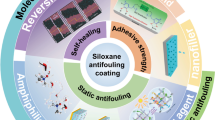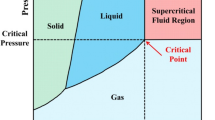Abstract
The formation of appropriate surface patterns on hydrophobic surfaces leads to a general change in their wettability and the contact angle increases substantially. Such coatings are of great technical interest, especially if aqueous media are concerned as in the prevention of ice-adhesion. For this reason various fluorine containing nanocomposite coatings have been developed by sol-gel processing.
The morphology of these hydrophobic surfaces has been controlled by varying the content of silica particles regarding size, degree of aggregation, and concentration. The wettability is characterized by the measurement of dynamic contact angles against water. The complete range of different wettability regimes is accessible, i.e. smooth surfaces (both low advancing contact angle and hysteresis between advancing and receding contact angle), surfaces within the Wenzel regime (high advancing contact angle and hysteresis), and superhydrophobic surfaces (high advancing contact angle and low hysteresis). The wettability is correlated with the surface roughness as determined using a profilometer or AFM.
The wettability of superhydrophobic surfaces is greatly dependent on the surface tension of the liquid. By comparison of the tiltangle θt of a smooth and a superhydrophobic surface, a critical surface tension γc is identified, where θt (smooth surface) = θt (microstructured surface). The microstructured surface provides a better run-off of liquids γlg > γc ≈ 55 mN·m−1.
Similar content being viewed by others
References
H. Schmidt, in Organosilicon Chemistry II, edited by N. Auner and J. Weis (VCH, Weinheim, 1996), p. 737.
P. Müller, S. Pilotek, A. Poppe, and H. Schmidt, in 2. Wörlitzer Workshop (Fördergemeinschaft Dünne Schichten, Dessau, 2000).
T. Onda, S. Shibuichi, N. Satoh, and K. Tsujii, Langmuir 12, 2125 (1996); K. Tadanaga, N. Katata, and T. Minami, J. Am. Ceram. Soc. 80, 1040 (1997); M. Miwa, A. Nakajima, A. Fujishima, K. Hashimoto, and T. Watanabe, Langmuir 16, 5754 (2000); A. Nakajima, K. Hashimoto, and T. Watanabe, Monatshefte f¨ur Chemie 31, 132 (2001).
R.E. Johnson and R.H. Dettre, in Surface and Colloid Science, vol. 2, edited by E. Matijevic (Wiley, New York, 1969), p. 85.
D. Öner and T.J. McCarthy, Langmuir 16, 7777 (2000).
Rights and permissions
About this article
Cite this article
Pilotek, S., Schmidt, H. Wettability of Microstructured Hydrophobic Sol-Gel Coatings. Journal of Sol-Gel Science and Technology 26, 789–792 (2003). https://doi.org/10.1023/A:1020779011844
Issue Date:
DOI: https://doi.org/10.1023/A:1020779011844




